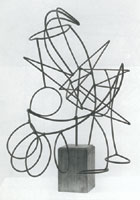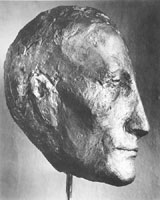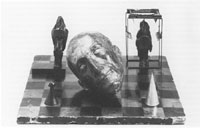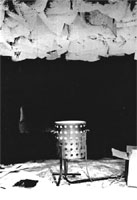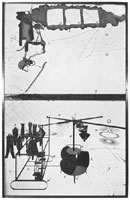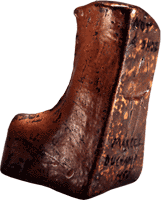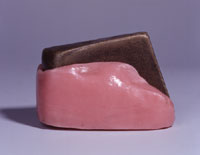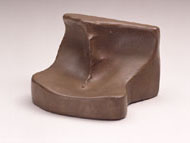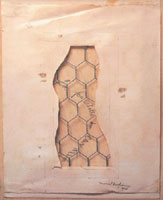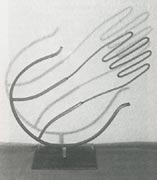by Thomas Girst
|
|||||||||||||||||||||||||||
|
"an object by me underneath the tent"
Born in Oberstammheim, Switzerland, in 1911, Isabelle Waldberg stayed in New York between 1941 and 1946. A former member of George Batailles's secret society Acéphale, she soon joined the Surrealists and met, among others, André Breton, Marcel Duchamp and Max Ernst. At the time she was working on sculptures made of flexible wood sticks (Fig.21) Isabelle Waldberg, Fruit de Mer, 1943 (1948)), some of which were included in Peggy Guggenheim's famous Art of this Century exhibition in 1944. "Constructions" is the general term Waldberg used for her twisted wooden objects and starting in 1948, she would cast them in iron. It was one of her "constructions" that she used for the window display of Breton's Le Surréalisme et la Peinture (11) . When Waldberg returned to Europe after WWII in 1946, Duchamp offered her to stay at his abandoned studio apartment in Paris, at 11 rue Larrey, well-known for the door Duchamp built therein, the one both open and closed at the same time. In 1958, she would cast a small bronze portrait of him (Fig.22) and yet another one in 1978/79, incorportating chess Figures and a device Man Ray used for drying negatives (Fig.23).
"old paper from M.'s studio en chute" The paper en chute casts a shadow that certainly must have been to M. Duchamp's liking. The light source resting at the bottom of the window display does not look unlike the stove used by Duchamp for another, better-known installation, Twelve Hundred Coal Bags Suspended from a Ceiling over a Stove, which he created for the Exposition Internationale du Surréalisme at the Galerie Beaux-Arts, Paris (January – February 1938) (Fig.24). The "tent" is what Isabelle Waldberg refers to in regard to Duchamp's old paper suspended from the window's ceiling, and "en chute" is how she describes it too, as in chute d'eau or waterfall. "Paper fall" is what Arturo Schwarz picks up from her, comparing the shape to a "wedding veil, which may be a reminiscence of the Bride's Garment in the Large Glass, 1915-1923, where it appears just above the Waterfall […]"(12). The Bride's clothes are never mentioned throughout Duchamp's notes but are only and first referred to in Breton's essay Lighthouse of the Bride (1934) (13), where numbers scrawled across a photograph of the Large Glass point out its different components (Fig.25). It is number 13, which, according to Breton (or is it Duchamp?) signifies the location of "Vêtement de la mariée" or clothes of the bride. Of course, it is none other than Le Surréalisme et la Peinture which first makes Breton's important essay widely available in bookform. But there is much more to it. The "paper fall" might also just be what it resembles most: a waterfall, exactly as in Given: 1. The Waterfall / 2. The Illuminating Gas. Besides the Waterfall, the Illuminating Gas is there, too, resting at the bottom. It is time now to leave Isabelle Waldberg's description of the window in her letter to her husband Patrick. The remainder of my argument shall inextricably link Duchamp's window display for Breton's Le Surréalisme et la Peinture to Given, his last major work.
Julien Levy We have to return to Duchamp's shoes. In January 1936, a year after Magritte painted Le Modèle Rouge, it was first exhibited at Julien Levy's New York gallery. At the end of the same year, Black Sun Press, New York, published Levy's book on Surrealism. Within this anthology, Levy describes Duchamp as an “ideal shoemaker” (14) who no longer makes shoes but who is still steeped in the act of creation: "A shoemaker makes shoes. A manually proficient shoemaker makes superb shoes. An ideal shoemaker no longer makes shoes, but ideas in his medium. He is divorced from his material objective and, like a madman, he would cut leather and sew leather and choose leathers like a runway engine, except that he has an idea."(15) Duchamp had stopped painting in 1918, but - besides pursuing a career in chess - never ceased to be
And it doesn't stop here: In 1950, Marcel Duchamp presents Julien Levy with a small sculpture made of galvanized plaster, something Levy wouldn't part with until his death in 1981. The name of the sculpture is Not a Shoe (Fig.26) and the very first of a total of four small objects that would later be determined to be artistic side-products of his secret involvement with the production of Given. No one knew this at the time, of course, and when exhibited, those sculptures were mostly thought of as being "bizarre artifacts"(17). Not a Shoe is the only one not turned into an edition.
It most closely resembles the Wedge section of the Wedge of Chastity (Fig.27) which in turn relates to the central vertical line of Female Fig Leaf (Fig.28). The latter is believed to be a mock or negative cast of the primary female genitalia, the part most prominently presented to the viewer of Given. Why present Levy with the first hint of Given? Why not. It was Levy, eventually, who would recall Duchamp's first mentioning of a similar project. In his Memoirs of an Art Gallery (1977), he wrote of first meeting Duchamp fifty years earlier, on board of the Paris, a transatlantic steamer taking both from New York to Le Havre, France, in 1927. “Marcel toyed with two flexible pieces of wire, bending and twirling them, occasionally tracing their outline on a piece of paper. He was devising a mechanical female apparatus [...], a soft anatomical machine. He said, jokingly, he thought of making a life-size articulated dummy, a mechanical woman whose vagina, contrived of meshed springs and ball bearings, would be contractile, possibly self-lubricating, and activated from a remote control, perhaps located in the head and connected by the leverage of the two wires he was shaping. The apparatus might be used as a sort of
Notes
18.
Julien
Levy, Memoirs of an Art Gallery, New York: Putnam, 1977, p. 20
[original italics]. The quotes are from the beginning of Levy's "Duchampiana"
article which first appeared in View magazine (New York; 5, 1,
March 1945, pp. 33-35). The original does not contain the paragraph
quoted and it is my assumption that Julien Levy added his observations
after seeing Given installed at the Philadelphia Museum following
Duchamp's death in 1968. The impact of seeing Given might have
brought back the memory of their conversation of 1927, since, according
to Levy-scholar Lisa Jacobs, the art dealer did not keep a diary (e-mail
to the author of September 15, 1999).
Figs.
24-29,
Footnote18
|
|||||||||||||||||||||||||||
